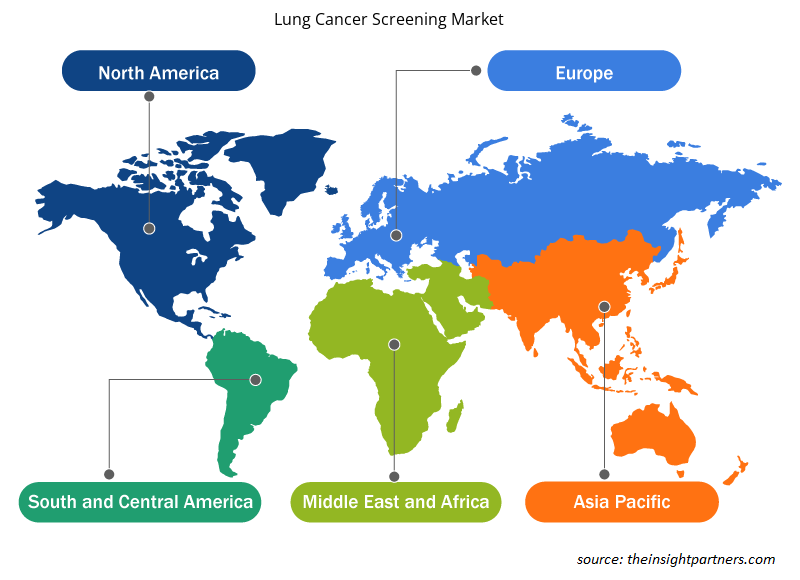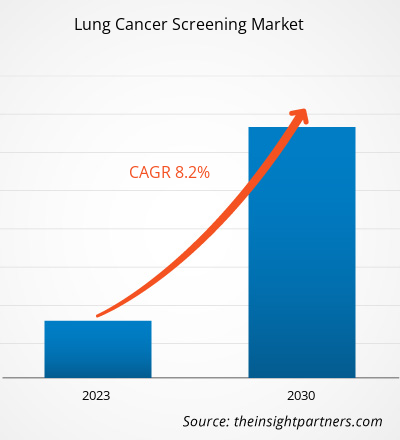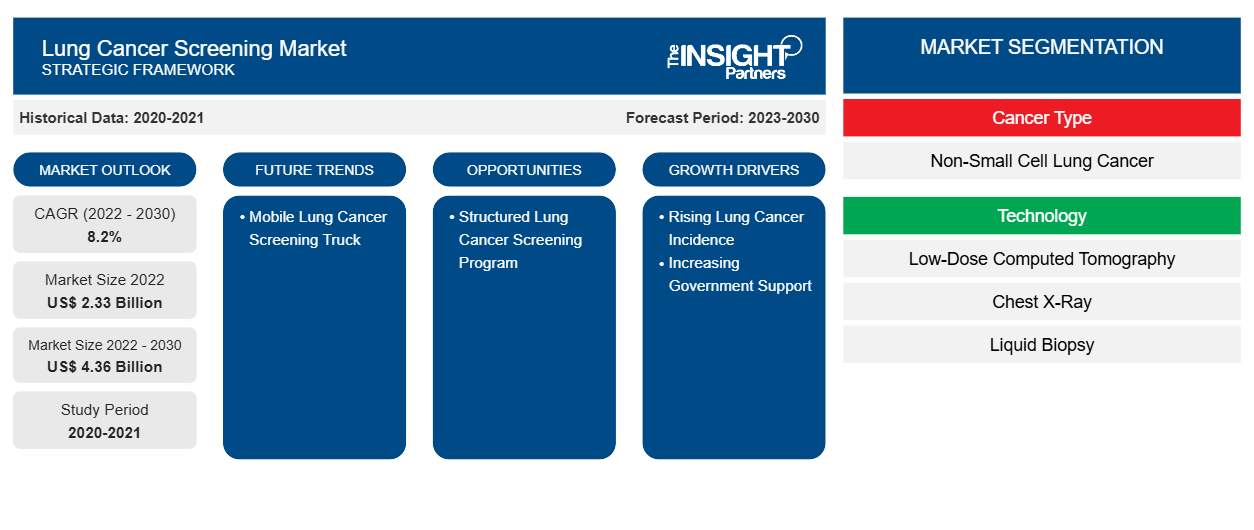[연구보고서] 폐암 검진 시장 규모는 2022년 2,326.5백만 달러에서 2030년 4,363.95백만 달러로 성장할 것으로 전망됩니다. 2022년부터 2030년까지 연평균 성장률 8.2%를 기록할 것으로 예상됩니다.
분석가 관점:
폐암 발병률 증가와 정부 지원 증가로 폐암 검진 시장이 확대되고 있습니다. 폐암이 만연해지면서 이 질병과 관련 치료에 대한 인식도 높아지고 있습니다. 또한 정부 이니셔티브는 더 나은 저렴한 검진과 유리한 환불 정책을 제공하며, 이는 폐암 검진 시장 성장을 촉진할 것으로 예상됩니다. 폐암 검진 시장의 주요 업체는 협력을 통한 전략적 이니셔티브에 집중하여 지리적 범위를 확대하고 대규모 고객 기반을 충족할 수 있는 역량을 강화하고 있습니다. 예를 들어, 2021년 11월 GE Healthcare와 Optellum은 폐암의 정밀 진단 및 치료를 발전시키기 위해 협력했습니다. 이 두 회사는 함께 폐암 진단에서 가장 큰 과제 중 하나를 해결하고, 제공자가 양성 또는 암성일 수 있는 의심스러운 병변인 폐 결절의 악성 여부를 판단하도록 돕고자 합니다.
폐암 검진 시장 - 시장 개요:
폐암 검진은 폐암 위험이 높은 건강한 사람들의 폐암을 발견하는 데 사용되는 프로세스입니다 . 폐암 검진은 장기 흡연자이고 폐암의 징후나 증상이 없는 노인에게 권장됩니다. 의사는 폐의 LDCT 스캔을 사용하여 폐암을 찾습니다. 폐암이 일찍 발견되면 치료를 통해 치료할 가능성이 더 높습니다.
폐암 검진 시장은 기술, 암 유형, 연령대 및 최종 사용자로 세분화됩니다. 이 보고서는 시장 동향, 기술 발전, 시장 역학 및 주요 시장 참여자의 경쟁 환경 분석과 같은 매개변수에 중점을 두고 글로벌 폐암 검진에 대한 통찰력과 심층 분석을 제공합니다.
귀하의 요구 사항에 맞게 이 보고서를 사용자 정의하세요
이 보고서의 일부 또는 국가 수준 분석, Excel 데이터 팩을 포함하여 모든 보고서에 대한 사용자 정의를 무료로 받을 수 있으며 신생 기업 및 대학을 위한 훌륭한 혜택과 할인 혜택을 이용할 수 있습니다.
- 이 보고서의 주요 시장 동향을 알아보세요.이 무료 샘플에는 시장 동향부터 추정 및 예측까지 다양한 데이터 분석이 포함됩니다.
시장 동인:
폐암 발병률 증가로 폐암 검진 시장이 성장
폐암은 전 세계적으로 사망의 주요 원인 중 하나입니다. 폐암 검진은 암 예방 접근 방식의 중요한 구성 요소입니다. 폐암 환자의 예후는 질병이 조기에 진단될 때 더 좋으므로 폐암 위험이 높은 사람은 폐에서 암성 성장의 형성을 감지하기 위해 정기적인 검사를 받는 것이 좋습니다. 미국 폐암 협회의 2023년 추정에 따르면 약 238,340건의 새로운 폐암 사례가 등록되었으며 이 중 120,790건은 여성에서, 117,550건은 남성에서 보고되었습니다. 또한 국립 생명공학 정보 센터(NCBI)에 따르면 매년 이탈리아에서 약 41,000건의 새로운 폐암 진단과 34,000건의 사망이 기록됩니다. NCBI), each year, ~41,000 new diagnoses of lung cancers and 34,000 deaths are recorded in Italy.
Cancer Australia 2023 보고서에 따르면, 2022년에 약 14,529건의 새로운 폐암 사례가 진단되었으며, 이 중 7,707건은 남성이고 6,822건은 여성이었습니다. 등록된 새로운 암 사례의 약 9%가 2022년에 진단되었으며, 폐암으로 인한 총 사망자는 8,664명으로 추산됩니다.
따라서 전 세계적으로 폐암 발생률이 증가함에 따라 폐암 검진 프로그램이 시작되고 있으며, 이로 인해 폐암 검진 시장이 성장하고 있습니다.
폐암 검진 시장 - 세그먼트 분석:
폐암 검진 시장은 암 유형에 따라 비소세포 폐암(NSCLC)과 소세포 폐암으로 나뉩니다. NSCLC 세그먼트는 2022년에 더 큰 시장 점유율을 차지했으며 예측 기간 동안 8.0%의 CAGR로 성장할 것으로 예상됩니다. 이 세그먼트의 시장 지위는 전 세계적으로 NSCLC 사례가 증가하고 있기 때문입니다. NSCLC는 소세포 폐암보다 느리게 진행됩니다. 일반적으로 진단될 때까지 환자 신체의 다른 부분으로 퍼집니다. 따라서 조기 진단과 치료가 중요합니다. National Foundation for Cancer Research에 따르면 NSCLC는 10건 중 약 9건을 차지합니다. 같은 출처에 따르면 대세포 미분화 암 폐암은 모든 NSCLC 진단의 약 10~15%를 차지합니다.
폐암 검진 시장 - 지역 분석:
폐암의 유병률이 증가함에 따라 조기 발견을 위해 검진이 매우 중요해졌습니다. 폐암 검진은 장기 흡연자이며 폐암과 관련된 증상이 없는 노인에게 권장됩니다. 의사는 저선량 컴퓨터 단층촬영(LDCT) 스캔이나 X선을 사용하여 검진합니다.
2022년 6월 저널 오브 토라식 온콜로지에 게재된 "독일의 폐암"이라는 제목의 기사에 따르면, 암은 독일에서 두 번째로 흔한 사망 원인 중 하나로, 모든 사망자의 25%를 차지합니다. 남성의 경우 폐암은 심혈관 질환에 이어 두 번째로 높은 사망률을 기록하며, 모든 사망률의 6.5%를 차지합니다. 남성과 여성의 연령 표준화 발병률이 각각 52.1명과 32.7명(10만 명당)으로, 폐암은 남성에서 두 번째, 여성에서 세 번째를 차지합니다(각각 모든 신규 진단 암의 13.3%와 9.4% 차지). 암 진단의 평균 연령은 남성의 경우 70세, 여성의 경우 69세이며, 모든 환자의 52%가 4기입니다. 흡연 습관의 장기적인 변화로 인해 1990년대부터 여성과 남성의 발병률이 수렴되었습니다. 현재 독일에서는 남성 4명 중 1명(27.0%)과 여성 5명 중 1명(20.8%)이 규칙적으로 흡연을 하고 있습니다.
독일 국가 암 계획은 독일에서 일반적인 종양학 치료를 제공하기 위해 장기 암 센터(폐암 센터), 종양학 센터 및 종합 암 센터를 지정합니다. 2020년 현재 전국적으로 79개 기관의 64개 폐암 센터가 인증을 받았습니다. 또한 향후 몇 년 안에 독일 의료 시스템에서 폐암 검진을 시행할 것으로 예상됩니다. 예를 들어, 폐 검사 연구인 HANSE는 주로 전체적이고 효과적인 폐암 검진 프로그램을 시행하여 독일의 인증된 폐암 센터의 현재 인프라에 통합할 수 있다는 증거를 제공하는 시범 프로그램으로 의도되었습니다. HANSE는 북부 독일 지역에서 5,000명의 고위험 후보자를 대상으로 통제된 폐암 검진, 관련 심장 및 폐 합병증에 대한 검진, 잠재적인 예측 바이오마커 평가의 타당성을 조사합니다 . 검진은 3개의 승인된 폐암 센터 사이를 순환하는 이동식 CT 트럭을 통해 이루어집니다. 또한 독일은 개인화된 모집 접근 방식, 개별화된 스크리닝 간격, 개선된 방사선 기준 등을 포함한 스크리닝의 여러 가지 혁신적인 수정 사항을 조사하는 전향적 시험인 유럽 "4 in the Lung Run-Study"에 두 곳의 기관과 함께 참여하고 있습니다.
따라서 독일에서 폐암 발생률이 증가하고, 독일 의료 시스템에 폐암 검진이 시행됨에 따라 폐암 검진 시장도 성장할 것으로 예상됩니다.
폐암 검진 시장 - 주요 업체 분석:
폐암 검진 시장 분석에는 Intelerad Medical Systems Incorporated, Nuance Communications Inc, GE HealthCare Technologies Inc, Medtronic Plc, Canon Medical Systems Corp, Koninklijke Philips NV, Siemens AG, Aetna Inc, bioAffinity Technologies, Inc., LungLife AI, Inc.와 같은 업체에 대한 연구가 포함되었습니다. 폐암 검진 시장의 업체 중에서 Siemens AG와 Medtronic Plc는 다양한 제품 포트폴리오를 제공하기 때문에 상위 2개 업체입니다.
폐암 검진 시장 지역 통찰력
Insight Partners의 분석가들은 예측 기간 동안 폐암 검진 시장에 영향을 미치는 지역적 추세와 요인을 철저히 설명했습니다. 이 섹션에서는 북미, 유럽, 아시아 태평양, 중동 및 아프리카, 남미 및 중미의 폐암 검진 시장 세그먼트와 지리에 대해서도 설명합니다.

- 폐암 검진 시장에 대한 지역별 특정 데이터 얻기
폐암 검진 시장 보고서 범위
| 보고서 속성 | 세부 |
|---|---|
| 2022년 시장 규모 | 23억 3천만 달러 |
| 2030년까지 시장 규모 | 43억 6천만 달러 |
| 글로벌 CAGR (2022-2030) | 8.2% |
| 역사적 데이터 | 2020-2021 |
| 예측 기간 | 2023-2030 |
| 다루는 세그먼트 | 암 유형별
|
| 포함된 지역 및 국가 | 북아메리카
|
| 시장 선도 기업 및 주요 회사 프로필 |
|
폐암 검진 시장 참여자 밀도: 비즈니스 역학에 미치는 영향 이해
폐암 검진 시장은 소비자 선호도의 변화, 기술 발전, 제품의 이점에 대한 인식 증가와 같은 요인으로 인해 최종 사용자 수요가 증가함에 따라 빠르게 성장하고 있습니다. 수요가 증가함에 따라 기업은 제품을 확장하고, 소비자의 요구를 충족하기 위해 혁신하고, 새로운 트렌드를 활용하여 시장 성장을 더욱 촉진하고 있습니다.
시장 참여자 밀도는 특정 시장이나 산업 내에서 운영되는 회사나 기업의 분포를 말합니다. 주어진 시장 공간에 얼마나 많은 경쟁자(시장 참여자)가 존재하는지 그 규모나 전체 시장 가치에 비해 나타냅니다.
폐암 검진 시장에서 활동하는 주요 회사는 다음과 같습니다.
- 인텔라드 의료 시스템 주식회사
- 뉘앙스 커뮤니케이션 주식회사
- GE 헬스케어 테크놀로지 주식회사
- 메드트로닉 주식회사
- 캐논 메디컬 시스템즈 주식회사
면책 조항 : 위에 나열된 회사는 어떤 특별한 순서에 따라 순위가 매겨지지 않았습니다.

- 폐암 검진 시장의 주요 기업 개요를 알아보세요
폐암 검진 시장 - 최근 동향:
합병 및 인수와 같은 무기적 및 유기적 전략은 폐암 검진 시장에서 회사들에 의해 널리 채택됩니다. 최근 몇 가지 주요 시장 개발은 다음과 같습니다.
- 2022년 6월 Royal Philips는 Biodesix, Inc.와 협력하여 Biodesix의 Nodify Lung 혈액 기반 폐 결절 위험 평가 검사 결과를 Philips Lung Cancer Orchestrator 폐암 환자 관리 시스템에 통합했습니다.
- 2022년 8월, Intelerad Medical Systems는 유방 영상 및 폐 검진 생산성을 향상시키는 소프트웨어 공급업체인 PenRad Technologies, Inc.를 인수했습니다. 이 인수를 통해 Intelerad의 유방 조영술 및 폐 분석 제품 제공이 확대되어 방사선과 의사의 워크플로가 최적화되고 환자 건강 결과가 향상되었습니다.
- 2021년 5월, Genetron Holdings Limited는 중국 의료 장비 박람회에서 Siemens Healthineers와 협력했습니다. 이 협력은 중국 병원에서 Genetron의 S5 플랫폼과 폐암 8유전자 IVD 검사의 대규모 적용을 촉진하고 NSCLC 환자에게 효율적이고 정확한 개인화된 진단 및 치료 지침을 제공했습니다.
- 과거 분석(2년), 기준 연도, CAGR을 포함한 예측(7년)
- PEST 및 SWOT 분석
- 시장 규모 가치/거래량 - 글로벌, 지역, 국가
- 산업 및 경쟁 환경
- Excel 데이터세트
최근 보고서
관련 보고서
사용 후기
구매 이유
- 정보에 기반한 의사 결정
- 시장 역학 이해
- 경쟁 분석
- 고객 인사이트
- 시장 예측
- 위험 완화
- 전략 기획
- 투자 타당성 분석
- 신흥 시장 파악
- 마케팅 전략 강화
- 운영 효율성 향상
- 규제 동향에 발맞춰 대응





















 무료 샘플 받기 - 폐암 검진 시장
무료 샘플 받기 - 폐암 검진 시장